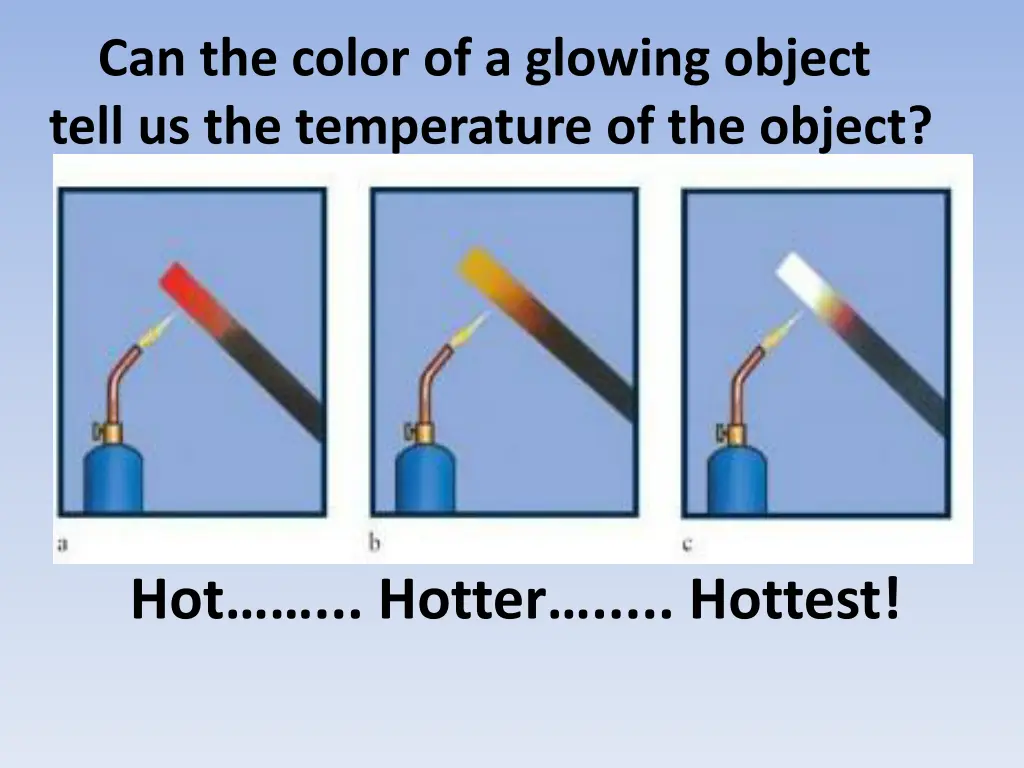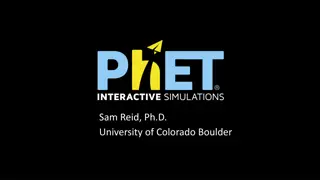
Understanding the Relationship Between Glowing Object Colors and Temperature
Exploring the correlation between the color of a glowing object and its temperature using Wien's Displacement Law in physics to determine the peak radiation wavelength emitted by black bodies. Discover how astronomers use this law to estimate the temperature of stars in the universe.
Download Presentation

Please find below an Image/Link to download the presentation.
The content on the website is provided AS IS for your information and personal use only. It may not be sold, licensed, or shared on other websites without obtaining consent from the author. If you encounter any issues during the download, it is possible that the publisher has removed the file from their server.
You are allowed to download the files provided on this website for personal or commercial use, subject to the condition that they are used lawfully. All files are the property of their respective owners.
The content on the website is provided AS IS for your information and personal use only. It may not be sold, licensed, or shared on other websites without obtaining consent from the author.
E N D
Presentation Transcript
Can the color of a glowing object tell us the temperature of the object? Hot ... Hotter ..... Hottest!
Blackbody Simulation Lab And Wien s Displacement Law NIS, Taldykorgan Grade 11 Physics
Objectives: To Use Wien s Displacement Law to solve problems for estimating of black body radiation. To collect, graph and analyze data, from a computer simulation, that allows the calculation of Wien s constant. To understand why Wien s Law is the most important tool use by Astronomers to determine the temperature of a star.
Wiens Law and Constant b The Wien's Displacement Law state that the wavelength carrying the maximum energy is inversely proportional to the absolute temperature of a black body. maxT = b Where, max= Wavelength of maximum intensity ( meters ) T = Temperature of the blackbody ( kelvin ) b = Wien's displacement constant = 2.898 106nm K The precise value of b is stated as 2.897 7721 x 10-3m K with a standard uncertainty of +/- 0.000 0026 x 10-3m K
Wiens displacement law with displacement line
Vocabulary Terms of Astrophysics Astronomy Term Absolute Magnitude M Apparent Magnitude brightness m Definition The apparent magnitude a star would have at 10 parsecs (32.6 light years) Each division is 2.51 times brighter than the next magnitude, sun has m= -26 Russian " " Kazakh " " Apparent Magnitude scale Intensity A modern version of Hipparchus scale Power per unit area at the observer: I=P/4 r2 Total power radiated by a star (joules/sec=watts), depends on the temperature and distance between the star and the observer. L d2T4 The shift, relative to the background, caused by a shift in the observer s position. The distance at which one AU subtends an angle of one arc second (1/3600th of a degree), 1 pc = 3.26 light years A scale created by in 120 BC where 1 is the brightest star and 6 is the dimmest star Luminosity Parallax Angle Parsec Relative Brightness scale Spectral Class A classification of a star based on features of its spectrum which also indicate its surface temperature and chemical composition Defines a relationship between the peak radiation emitted by a star and its temperature. Wein Wein s Displacement Law
Wilhelm Wien, 1864-1928 Wilhelm Wien "led us to the very gates of quantum physics". Words of Max von Laue Born in Prussia, son of landowner/farmer Professor of Physics at University of Munich First to define an ideal blackbody Received Nobel Prize in Physics in 1911 for work on temperature and entropy of radiation Reference: Wilhelm Wien Biographical, from NoblePrize.org http://www.nobelprize.org/nobel_prizes/physics/laureates/1911/wien-bio.html
References: Wilhelm Wien Biographical, from NoblePrize.org http://www.nobelprize.org/nobel_prizes/physics/l aureates/1911/wien-bio.html Precise value of b : http://physics.nist.gov/cgi-bin/cuu/Value?bwien Star Colors and Temperatures http://docs.kde.org/stable/en/kdeedu/kstars/ai- colorandtemp.html






















